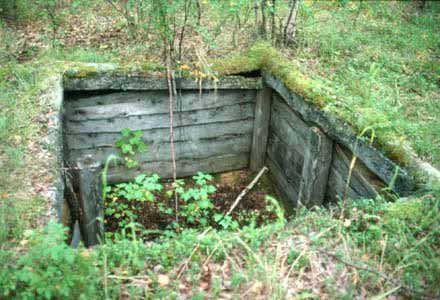|
|
|
||||
| About me
|
|||||
| Guest book
|
Historical essay For those who have forgotten but do not want to forget... |
||||
ESSAY: |
|
||||
|
|||||
Мертвая дорога часть 1
Dead Road part 1 (English) Dead Road part 2 (English) Dead Road part 3 (English)
Не спорьте о допустимости клонирования человека! Человека уже давно клонировали...
Но толку из этого не вышло никакого...
|
DEAD ROAD - MUSEUM OF COMUNISM
В истории человечества каждая великая тирания оставляла в назидание потомкам символ своего величия, какой-нибудь гигантский памятник, сработанный руками ее рабов. Но если египетские пирамиды до сих пор хранят останки фараонов, римский акведук столетиями доставлял воду населению, то монументы-символы эпохи социализма столь же бесплодны, как и сама идея, их породившая. По сталинским каналам не перевозят грузов, гидроэлектростанции и моря-водохранилища разрушили природу, так и не обеспечив страну электричеством, а унылые городские дома-коробки готовы рухнуть на головы их обитателей. Дорога Салехард-Игарка, или 501-я стройка, как ее называли миллионы советских зэков, наверное, самый яркий тому пример. Эта "дорога в никуда" сквозь тайгу и болота - не есть ли та самая дорога в "светлое будущее", которую славили сталинские акыны? Все, что осталось от нее теперь - это убогий зэковский скарб, искореженная земля да горы ржавеющего инструментария. Да еще, быть может, бродят в ее окрестностях потомки "верных Русланов", у которых вид колонны невольников уже не вызывает никаких рефлексов. Остались еще легенды. Даже в мое лагерное время старые зэки вспоминали 501-ю стройку недобрым словом. Более всего они сетовали не на голод и холод, не на жестокость обращения - их-то хватало всюду в ГУЛАГе - но именно на бесцельность творимого там жертвоприношения. Ведь и рабу не безразлично на что потратили его жизнь. Не о том ли и теперь наши мысли? Глядя на развалины былой "великой" стройки коммунизма, невольно думаешь: зачем все это было? За что? Искать ответ на этот вопрос будут, наверное, многие поколения наших потомков.
Among numerous other unsuccessful Stalinist "Great Constructions" (the White Sea Canal, The Baikal-Amur Main Railway Line and others) the epic of the Salekhard-Igarka Railway Line is distinguishable by its utter purposelessness. Initiated in a hurry by orders of the top Soviet leaders, the construction was absolutely unprepared in technological and organizational terms. The irresponsible Stalinist politicians and captains of industry were attracted to the project because it allowed them to use one of the so-called basic "advantages of socialism" -- the right of the ruling communist party to deprive the half-starved, war-devastated country of enormous means and resources by senselessly wasting them in an attempt to solve a problem that held promise of personal political success. It is said that among the hired civilian builders of the construction there were to be found selfless enthusiasts inspired by the unprecedented scope and challenge of the task. It may have been so, though this kind of enthusiasm could hardly have been widespread. Rather, the majority of "enthusiasts" had no other way of sustaining their life in conditions of the Stalinist state-run economy with its mass deportations of population to Siberia for class or other reasons, its registration system of enslaving the workers, and the beggarly wages paid to them. It should be noted that all the volunteer 1participants of the project regarded it as quite natural that the work force of the "Construction of Communism" consisted of cruelly oppressed slaves -- prisoners of the Stalinist GULAG, on whose shoulders lay all the unbearable burden of the building work in natural conditions that were exceptionally harsh even by the standards of Northern Siberia. And those difficulties were multiplied by the blind inhuman voluntarism of the USSR top party politicians, the cowardice, incompetence and cruety of the industrial management. The arduous toil of all that motley collective body was wasted: the construction has for ever remained uncompleted. Up to now not a single section has been used on the Dead Road which turned into a death road for dozens of thousands of prisoners. Today the final result of the gigantic Stalinist project seems quite logical. The decision the USSR government took on the construction of the Salekhard-Igarka Railway Line as well as the methods of its being translated into life repeated in miniature the monstrous experiment of the building of Socialism started by the Bolshevik Party in October 1917. The results turned out to be sufficiently similar. In this book we propose to tell about the construction of the Dead Road and its builders. The contemporary original photo materials were obtained by the authors during their special expeditions to the Eastern sector of the Construction. They received historical and technicasl information about the Road mostly from oral sources: testimony of the participants of the construction. The old photos come from private and open state archives. Unfortunately the bulk of the GULAG archives concerning this Construction still remains closed for investigation, so our story will be incomplete. Still, we hope that the photo and documentary materials we have collected, will give the reader an adequate idea of the purposes and methods of the Stalinist-type economy and the scope and chcaracter of the economic activity of Soviet GULAG by the example of one of its most senseless creations -- the Salekhard-Igarka Railway Line. The authors wish to express their heartfelt gratitude to all those who contributed to the publication of this photo-album: participant of the Dead Road Construction, former political prisoner L. Shereshevsky; the first independent investigators of the Salekhard-Igarka Railway Construction A. Nickolsky and A. Berzin who kindly placed at the authors' disposal part of the documents and photographs they had collected; participants of the expedition to the Dead Road headed by A. Vologodskii, co-author of the book, and particularly to M. Pokrovskaya, Y. Pototsky and D. Davidov who participated in processing the collected materials. The authors' latest expeditions were sponsored by the Moscow "Memorial" Society.
1. On the Instruction of the Government
When flying along the Polar Circle over the Northern part of the West-Siberian lowland, the traveller to-day will rarely see human habitations. For hundreds of kilometers there is not a single town, settlement or even hamlet. It is not by chance that these places are deserted here. The harsh natural conditions of Northern Siberia are too arduos for human life. In winter which lasts here eight months, the vast expanses are covered with snow up to two meters thick. The sun hardly ever appears from behind the horizon, the temperature drops to --50o C, with biting winds blowing. During the short polar summer people and animals are attacked by swarms of blood-sucking insects. All around there are marshes and marshes without end or bounds. The aboriginal population -- Nenetses, Selcoups, Ketts had since old times engaged in fishing and hunting, leading a nomadic life. The deer, the foundation of polar life, provided man with food, warmth, and habitation, serving as a means of conveyance over the vast desert distances.
Absence of roads, and the extremely low fertility of the land made other forms of existence practically impossible. Even the unpretentious and all-penetrating system of the Stalinist GULAG camps could extend its branches to this out-of-the-way place only towards the end of the 1940s. In those times the density of population here was as low as 1 person per 20 square kilometers. It is evident that building a long and expensive railway line in that God-forsaken part of Siberia was utterly unpromising. How then did it happen that a good one hundred thousand builders had, during four years, been stubbornly struggling to implement this insane plan? In the post World-War 2 years the Soviet Communist system reached its efflorescence. Inspired by the victory over the Nazis, it was seeking to apply its unheard-of abilities. Preparing for future victories in its clashes with the West, the government of the half-starved war-devastated country paid primary attention to perfecting its military technology and strategy. In those years the USSR developed numerous military projects, in particular the project of super long-range missiles and that of the A-bomb which was unique for its complexity and cost. In all those undertakings the Communist leadership relied on the structure of the USSR Ministry of Internal Affairs (MIA) it had established, headed at that time by the Stalinist hangman Lavrenty Beria, which concentrated in its hands huge research-project capacities, as well as the elaborately adjusted, unfailing mechanism of forced labour -- the GULAG. That gigantic consortium of slave camps had become by that time the USSR's biggest producer and contractor capable of concentrating, in a very short time, manpower sufficient, as it seemed to the country's leadership, to solve any economic tasks. In expectation of successful completion of the work on the creation of super-powerful nuclear weapons, the Stalinist Politbureau (Political Bureau of the Soviet Communist Party) considered in advancee projects of their location. Under the influence of those considerations, the USSR Council of Ministers (CM) adopted, on February 4, 1947, decision No. 228-104ss on the necessity of constructing beyond the Ural Mountain Range, on the coast of the Arctic Ocean, a large secret military port with a great complex of structures, in particular a ship-repair plant, and a road to it. In April of the same year USSR CM adopted, without even requiring the designers present technological or economic substantiation of the the project, a decision to start construction of the road. Fulfillment of the project -- the prospecting and building work, was entrusted to the USSR MIA and the Glavsevmorput (Main Northern Sea Way) Administration. The decision to create a huge strategic military base deep in the USSR territory might be partly explained by the inferiority complex of the then leadership of the country who still remembered how easily and quickly Hitler had reached Moscow, and what colossal efforts it had cost to develop a defense industry in the rear of the country. The leadership must have also been attracted by the prospect of inflicting blows, in case of an offensive war, from the deep rear on various points of the Northern Hemisphere by using the secret long-range missiles which were being devised at that time. All that has been said about the motives of the USSR leadership is, but our supposition. The true reasons for the construction of the port and the Road could probably be found among the Government documents, but even now, forty years later, they remain secret, inaccessible to investigators. Nevertheless, a more recent document is known, namely, the memorandum of P. K. Tatarintsev, Head of the Complex Northern Expedition of the Railway Project Administration (Zheldorproyekt), which explains the necessity of constructing the railway line and the seaport for quite peaceful reasons -- the needs of the region. The author of the memorandum says nothing about the purpose of building a huge port of the Northern Sea Route in a region whose waters are covered with a thick layer of ice about eight months of the year. The version that the construction of the port and the Railway had a military background which was current among the builders erecting those giants, seems quite probable. The military purpose of the project is indirectly also confirmed by the priority and secrecy of the construction work, and, besides, by its practically unlimited financing. The USSR government took a decision to cover all the actual construction expenses by the actual outlays, in other words it cleared off all the expenditures incurred by the building administrations. The USSR government, economizing on all the needs of its citizens, was extremely generous when the matter concerned the main strategic military projects such as, for instance, the creation of nuclear weapons (sponsored, like the Dead Road Construction, by the USSR MIA). However the case may be, the USSR government decided to build the future port in the lower reaches of the Ob inlet near Stone Cape. In March 1947, in accordance with the February USSR CM decision, 501 GULAG Administration which engaged in railway construction (called SULZHDS Northern Camps Railway Building Administration, and belonged to the so-called Main Administration of Railway Building Camps -- GULZHDS) energetically began to lay the 700 kilometer-long railway line from the Chum Station of the Kotlas-Vorkuta Railway to the North-East via Shchuchye and New Port towards Stone Cape. There was also a plan to build a 200 kilometer-long branch line as far as Labytnangy settlement on the left bank of the Ob. The center of the railway line construction to Stone Cape was the settlement of Abez situated not far from the confluence of the river Usa and the Pechora where the Pechora GULZHDS Administration had been situated when it was laying the Kotlas-Vorkuta Road. The chief of the construction was chekist colonel V. A. Barabanov. In Abez was also situated the "headquarters column" -- a camp of prisoners working at the building administration, the GULAG building centers and cultural institutions, as well as production camp columns of motor-car repair service, bridge-builders, railwaymen, etc. The building of the railway line began far to the North of Abez, in the direction of the Ob bank. The builders moved to the North at an average speed of 100 kilometers per season. By the spring of 1948, the rails of the road, fastened to the sleepers for the time being with two spikes only, had already reached the Polar Urals and had come up through the valley of the Ob river, close to the border of the Yamalo-Nenets National District. At the opposite end of the line, the builders were moving from North to South. During the short polar summer, ships and lighters crawled down the Ob inlet to the future Novy Port (New Port) and Stone Cape, bringing people, coal, foodstuffs, timber, engines, engine fuel, tools and equipment for the future building. On the left high bank of the Ob inlet two-storey adobe houses were being built for the management and command, low barracks for the prisoners -- building materials were being unloaded all the time. By the end of 1948, train service had been opened to "Obskaya" Station, and by a branch line to Labytnangy which provided passage to the river Ob. But the builders of the Railway Line were not destined to reach Stone Cape. In 1948, the project-survey expedition discovered a fatal mistake in the Kremlin scheme. It was established that the Stone Cape region was not suitable for the location of a large seaport: the depth of this part of the Ob inlet didn't exceed 5 meters with only a meter and a and a half near its banks. After this belated "discovery" which was rather unpleasant for the Stalinist governing body, the builders had either to deepen the bottom of the Ob inlet up to 10 meters over a vast space, or to give up the building of the railway to Stone Cape. The former alternative was not even within Stalinism's power. For this reason on January 29, 1949, the Council of Ministers resolved to put an end to the work, disregarding the money already spent on the construction of almost half the line (document No. 384-135ss). Completed was only a small part of the railway line between Chum and Labytnangy connecting the railway network of the European part of the country with the mouth of the Ob. In spite of this monstrous economic error which had cost the country's national economy a pretty penny, the Politbureau didn't give up the idea of constructing a gigantic sea port in the Northern seas. By the same January resolution the projected port was transferred still farther East -- to the lower reaches of the Yenisei river. A new railway was ordered to be laid to the East, 1, 300 kilometers along the Polar circle across the West Siberian lowland, from the city of Salekhard on the right bank of the Ob, across the Labytnangy settlement to the settlement of Yermakovo on the left bank of the Yenisei, and then to the city of Igarka lying on its right bank. The new variant of the railway was advertised as another triumph of Communist creative thought, as the first sector of the so-called Northern Trans-Siberian Main Line -- the cherished dream of the Stalinist regime. It was said that the railway would later be prolonged from Igarka to the North, up to the city of Dudinka and to the mining-and-steel works of the city of Norilsk, and then to the East up to Kolyma and the Okhotsk and Barents seas. (It thus turned out that the Railway Line was to unite the gigantic system of North-Siberian GULAG camps). Pathos of conquering the severe Siberian nature was propagated among the builders who were told that the Salekhard-Igarka Railway would promote the industrial development of the region, and by connecting the North-East of Siberia with the railway network of the European part of the country, it would help provide supplies to the port as well as to the Polar cities. The said connection was to be effected through the GULAG slave-constructed Kotlas-Vorkuta Railway Line which was transferred from MIA authority to the authority of the civilian Communications Ministry, which delivered to the central districts of the USSR coal from the mines of the northern cities of Vorkuta and Inta, oil fromthe Ukhta District and timber from the numerous GULESLAG (Administration of Timber Cutting Camps) situated on the territory of the Komi Autonomous Soviet Socialist Republic. It was rumored among the people that under each sleeper of that railway line a prisoner lay dead. When adopting the decision on the immediate building of a railway in those Polar regions, the Soviet government had to foresee and take into account numerous unfavorable factors. To begin with, the construction was planned in a region remote from the industrial districts by thousands of kilometers. The natural resources of the region being very poor, it was imperative to bring to this Northern wilderness literally everything necessary both for the construction of the road and for the life of the people from timber which doesn't grow in the tundra to technical equipment and man-power. Transportation of all this had to be managed over an area which tremendously hampered its progress. In winter, motor vehicles could move sluggishly along reindeer paths only, and in summer, they would get bogged down in the marshy soil. This considerably increased the labour expenditure of the builders. The task set by the Stalinist government not only complex and labour-consuming, was aggravated by the specific conditions of the Polar region. Abutments rammed into the permafrost are after some time forced out, icy lenses formed within the thick swampy ground, cause, when melting, downfalls of the earth and the settling of already built constructions. Builders carelessly disturbing the thin upper layer of the ground, change its heat insulation capacity. As a result, the permafrost border is displaced and the melted layers of the soil begin "to float" together with everything built on them. Even if the builders had succeeded in completing the construction of the railway to start traffic on it, the above-mentioned processes would have, by slowly but hourly bending the rails, ruining the embankment, bridges and station buildings, reduced all their efforts to nought. The railway would have demanded continuous repairs throughout its whole length, and its exploitation would have proved unprecedentedly labour-intensive. But let us imagine for a second that by some supreme effort it would have become possible to maintain the Salekhard -- Igarka railway in working condition. Then the problem would have arisen of economically inefficient cargo transportation, since the projected 1, 300 kilometer-long line was to run through impassable wasteland with only a few settlements of no great economic importance. Any sensible person would naturally wonder for what reason was it necessary to lay such a long line through the uninhabited and cheerless spaces of Polar Siberia, when more inhabited and more economically important parts of the USSR were in urgent need of means of communication. It might have been expected that the organizers of the "Constructions of Communism" who had just routed the Ob Inlet project, would ask of themselves this question as well as many others. And without repeating their mistake they should have conducted a thorough technical investigation of the feasibility of a new construction to make all the necessary preparations. In this case the impossibility of building an efficient railroad and its hopelessness would have become obvious not after, but before billions of people's rubles were wasted and thousands of human lives were lost. But nothing of the kind happened! The order issued by the leadership of the country again sternly demanded that the railroad be started in the shortest possible time. Nobody dared to contradict this order: the decree of the Council of Ministers to build the railroad was signed by the communist tyrant -- Comrade Joseph Stalin himself.
|
||||
| |
|||||
 |
 |
||||
| Red shift? | Труд в СССР является делом чести, совести, доблести и геройства. Photo by A. Vologodsky | ||||
|
|
|||||



 Владимир
Буковский
Владимир
Буковский Amidst
the boundless marshes of the West-Siberian lowland, through the low polar forests and
tundra, winding its way for hundreds of kilometers, stretches like a thin ribbon the
deserted Salekhard-Igarka Railway Line. The loneliness of these parts and the almost
complete absence of human cultural activity, contributed to the Dead Road and everything
that was at one time connected with it, having been preserved almost intact. And
today, forty years later, this gigantic museum of the Stalinist GULAG (the Chief
Directorate of Concentration Camps) of the later years, stands under the open sky, bearing
witness to the appalling conditions of the convicts' life, their slave labour, the chronic
inefficiency of the communist system.
Amidst
the boundless marshes of the West-Siberian lowland, through the low polar forests and
tundra, winding its way for hundreds of kilometers, stretches like a thin ribbon the
deserted Salekhard-Igarka Railway Line. The loneliness of these parts and the almost
complete absence of human cultural activity, contributed to the Dead Road and everything
that was at one time connected with it, having been preserved almost intact. And
today, forty years later, this gigantic museum of the Stalinist GULAG (the Chief
Directorate of Concentration Camps) of the later years, stands under the open sky, bearing
witness to the appalling conditions of the convicts' life, their slave labour, the chronic
inefficiency of the communist system. 